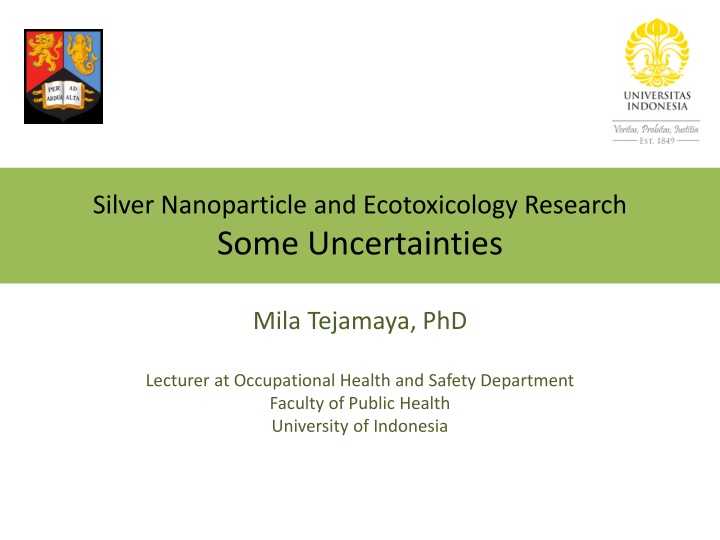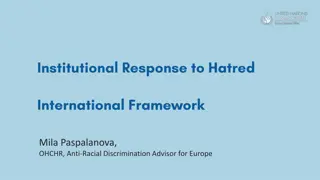
Silver Nanoparticle Ecotoxicology Research Insights
Explore the fascinating world of silver nanoparticles (AgNPs) and their implications in ecotoxicology research. Understand why AgNPs are of interest, the risks associated with their exposure, and the complex behaviors leading to uncertainties. Discover stability studies on citrate-capped and PVP-capped AgNPs, shedding light on their interactions in different media.
Download Presentation

Please find below an Image/Link to download the presentation.
The content on the website is provided AS IS for your information and personal use only. It may not be sold, licensed, or shared on other websites without obtaining consent from the author. If you encounter any issues during the download, it is possible that the publisher has removed the file from their server.
You are allowed to download the files provided on this website for personal or commercial use, subject to the condition that they are used lawfully. All files are the property of their respective owners.
The content on the website is provided AS IS for your information and personal use only. It may not be sold, licensed, or shared on other websites without obtaining consent from the author.
E N D
Presentation Transcript
Silver Nanoparticle and Ecotoxicology Research Some Uncertainties Mila Tejamaya, PhD Lecturer at Occupational Health and Safety Department Faculty of Public Health University of Indonesia
Why AgNPs are interesting? AgNPs are the most rapidly growing classes of nanoproducts AgNPs has been commercialized, so that the exposure to human and environment is expected silver in nanosize shows unique optical, electrical, magnetic and therapetic properties most of AgNPs applications in range of product are applied to bestow antimicrobial properties http://www.nanotechproject.org/cpi/site/assets/files/3551/chart_5.png
RISK = HAZARD EXPOSURE X HAZARD DRIVEN APPROACH: EXPOSURE DRIVEN APPROACH: Indication of AgNPs (eco)toxicity : Algae Bacteria Daphnia magna Zebrafish Fish Human (Fabrega 2011) AgNPs release from: Textile Paints Washing machine Waste water treatment etc
Complex behavior of AgNPs as source of uncertainties Homo-aggregation Hetero-aggregation Dissolution Shape transformation Other transformation NPs Stability Test (Levard, Hotze et al. 2012)
Stability Study: Citrate capped AgNPs Colour changes of citrate-coated AgNPs in different media immediately after media addition (left); after 24 hours (right) 0.4 0.4 0.35 0.35 0.3 0.3 Absorbance (a.u) Absorbance (a.u) 0.25 0.25 stock control 0.2 0.2 CM-10 CM-1 NM-1 0.15 NM-10 0.15 SM-1 SM-10 0.1 0.1 0.05 0.05 0 0 300 319 338 357 414 433 452 471 490 547 566 585 604 623 680 699 718 737 756 813 376 395 509 528 642 661 775 794 300 319 338 376 414 433 452 471 509 547 566 585 604 642 680 699 718 737 775 813 357 395 490 528 623 661 756 794 wavelength (nm) wavelength (nm)
Stability Study: PVP capped AgNPs 0.7 0.7 PVP capped AgNPs In CM-10 PVP capped AgNPs in CM-1 0.6 0.6 0.5 0.5 Absorbance Absorbance control control 0.4 0.4 1 day (a) 1 day (a) 0.3 0.3 7 days (a) 7 days (a) 13 days (a) 13 days (a) 0.2 0.2 21 days (a) 21 days (a) 0.1 0.1 0 0 300 319 338 357 376 395 414 433 452 471 490 509 wavelength (nm) 528 547 566 585 604 623 642 661 680 699 718 300 737 319 756 338 775 357 794 376 813 395 623 414 433 452 471 490 509 wavelength (nm) 528 547 566 585 604 642 661 680 699 718 737 756 775 794 813 0.7 0.7 PVP capped AgNPs in NM-10 PVP capped AgNPs in NM-1 0.6 0.6 0.5 0.5 Absorbance Absorbance control control 0.4 0.4 1 day (a) 1 day (a) 0.3 0.3 7 days (a) 7 days (a) 13 days (a) 13 days (a) 0.2 0.2 21 days (a) 21 days (a) 0.1 0.1 0 0 300 319 338 357 376 395 414 433 452 471 490 509 wavelength (nm) 528 547 566 585 604 623 642 661 680 699 718 737 756 775 794 813 813 300 319 338 357 376 395 414 433 452 471 490 509 wavelength (nm) 528 547 566 585 604 623 642 661 680 699 718 737 756 775 794
References: Fabrega, J., R. Zhang, et al. (2011). "Impact of silver nanoparticles on natural marine biofilm bacteria." Chemosphere 85(6): 961-966. Hassell v, M., J. Readman, et al. (2008). "Nanoparticle analysis and characterization methodologies in environmental risk assessment of engineered nanoparticles." Ecotoxicology 17(5): 344-361. Handy, R., F. Kammer, et al. (2008). "The ecotoxicology and chemistry of manufactured nanoparticles." Ecotoxicology 17(4): 287-314. Handy, R., R. Owen, et al. (2008). "The ecotoxicology of nanoparticles and nanomaterials: current status, knowledge gaps, challenges, and future needs." Ecotoxicology 17(5): 315-325. Hansen, S. F., B. H. Larsen, et al. (2007). "Categorization framework to aid hazard identification of nanomaterials." Nanotoxicology 1(3): 243-U369. Hassell v, M. and R. Kaegi (2009). Analysis and characterization of manufactured nanoparticles in aquatic environments. Environmental and Human Health Impacts of Nanotechnology. J. R. Lead and E. Smith, John Wiley & Sons, Inc.: United Kingdom. Kaegi, R., B. Sinnet, et al. (2010). "Release of silver nanoparticles from outdoor facades." Env. Pollut. 158(9): 2900-2905 Klaine, S. J., P. J. J. Alvarez, et al. (2008). "Nanomaterials in the environment: behavior, fate, bioavailability and effects." Environmental Toxicology and Chemistry 27(9): 27. Levard, C. m., E. M. Hotze, et al. (2012). "Environmental transformations of silver nanoparticles: impact on stability and toxicity." Environmental Science & Technology 46(13): 6900-6914. Nowack, B. and T. D. Bucheli (2007). "Occurrence, behavior and effects of nanoparticles in the environment." Env. Pollution 150(1): 5-22.
Thank you for your kind attention Mila Tejamaya tejamaya@ui.ac.id mila.tejamaya@gmail.com Department of Occupational Health and Safety C Building 1st floor Faculty of Public Health University of Indonesia Depok, West Java 16424 Phone: +62-21-78849033 Mobile: +62-811-18-10100 Fax: +62-21-7863487






















